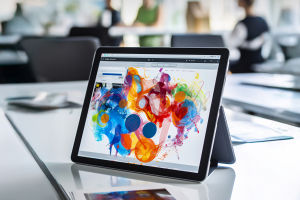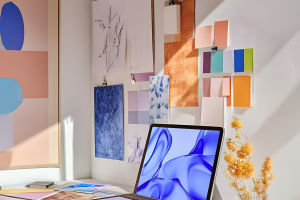Color is a powerful tool used in art, design, and branding to elicit emotional responses and influence perceptions.
Whether it's the calming effect of blue or the energy associated with red, colors can have a profound impact on how we feel and behave.
This phenomenon is not just psychological; it has deep cultural, biological, and historical roots.
From the design of a living room to the colors used in a corporate logo, our daily encounters with color influence our emotions, attitudes, and decisions in subtle yet significant ways. This article explores the role of color in evoking emotions and how artists, designers, and marketers harness its power.
The Psychology of Color
Colors have long been linked to psychological effects, and the study of this relationship is called color psychology. Different colors can trigger specific emotional reactions in people, even if they aren't consciously aware of it. For instance, warm colors such as red, orange, and yellow are often associated with excitement, warmth, and passion. Conversely, cool colors like blue, green, and purple tend to evoke feelings of calmness, tranquility, and serenity.
Researchers have found that these emotional associations with color can vary depending on factors such as age, culture, and personal experiences. However, there are some universal patterns that have been observed across different societies. For example, red often symbolizes love and danger, while blue is commonly associated with trust and stability.
Colors in Art and Their Emotional Impact
Artists have been using color intentionally for centuries to communicate mood and emotion in their work. In the visual arts, the color palette an artist chooses can define the emotional tone of an artwork. A painter's choice of colors can create a sense of warmth, tension, or sadness, often without needing words to convey the emotion.
• Red: Often referred to as the color of passion, red can evoke strong emotions such as love, anger, or excitement. It is frequently used in art to draw attention to a subject or to stimulate energy. In abstract art, red can symbolize intense feelings or evoke a sense of urgency.
• Blue: On the opposite end of the spectrum, blue is commonly associated with tranquility, depth, and introspection. Artists often use blue to create peaceful or melancholic atmospheres. It is also a color that invokes a sense of reliability and calmness, making it ideal for depicting serene landscapes or contemplative portraits.
• Yellow: A bright, vibrant color, yellow is often linked to joy, optimism, and creativity. It can bring a sense of happiness and hope to a composition, making it an effective tool for evoking positivity. However, when overused or used in darker shades, yellow can also symbolize caution or cowardice.
• Green: This color is strongly tied to nature and growth, symbolizing fertility, renewal, and harmony. Green has a soothing effect on the mind, helping people feel more grounded and connected to the environment. It is often used in art to represent balance and healing.
Color and Cultural Context
While color psychology explores the general emotional impact of colors, cultural context plays a significant role in how colors are interpreted. Different cultures associate specific meanings with particular colors, and these associations can greatly affect how a color is perceived emotionally.
For example, in many Western cultures, white is traditionally associated with purity, peace, and weddings, while in some Eastern cultures, it can symbolize mourning and death. Similarly, in the United States, red may evoke feelings of passion or danger, but in countries like Japan, it is often seen as a symbol of luck and prosperity.
Understanding these cultural differences is important for artists, designers, and marketers who are trying to use color effectively in a global context. By being mindful of the cultural significance of colors, they can ensure their message is not misinterpreted.
Color in Branding and Marketing
In the world of marketing and advertising, color plays a crucial role in shaping consumer behavior and brand perception. Companies often choose their brand colors carefully to create a particular image and evoke specific emotions in their audience. The right color can establish a strong connection with consumers, influencing their buying decisions and fostering brand loyalty.
• Red: Fast food often uses red in its logos and packaging because it is associated with excitement, appetite, and energy. Red stimulates action, which is why it is often used in calls to action and clearance sales.
• Blue: Brands use blue to convey trustworthiness and dependability. Blue's calming effect helps create a sense of security, making it a popular choice for technology companies, banks, and healthcare brands.
• Green: Companies use green to communicate a message of sustainability, health, and freshness. Green is particularly effective for brands that want to emphasize eco-friendliness or natural products.
• Yellow and Orange: These colors are often used by brands targeting younger or more energetic demographics, as they are associated with happiness, creativity, and enthusiasm.
Color in Interior Design
In addition to art and marketing, color plays a pivotal role in interior design. The colors chosen for a space can have a significant impact on the emotions and behavior of the people who occupy it. Designers carefully select colors to create certain moods or promote specific activities in different environments, such as homes, offices, and hospitals.
• Warm colors such as reds, oranges, and yellows are often used in living spaces and kitchens to create a welcoming, energetic environment. These colors can stimulate conversation, promote socializing, and even increase appetite.
• Cool colors like blues and greens are more commonly used in bedrooms and bathrooms, where relaxation and calmness are key. These hues can help lower stress levels and promote restful sleep.
• Neutral tones such as beige, gray, and white are frequently used in offices and workspaces to create an environment conducive to focus and productivity. These colors offer a clean, unobtrusive backdrop that allows other elements of the room to stand out.
The Emotional Language of Color
Color is much more than a visual element—it is a powerful language that communicates emotions, influences perceptions, and shapes experiences. By understanding the psychological and cultural significance of different colors, artists, designers, and marketers can use color as a tool to evoke specific emotional responses and create meaningful connections with their audience.
Whether used to create tranquility, excitement, or a sense of urgency, color is a subtle yet potent force that impacts how we engage with the world around us. As our understanding of color's emotional power deepens, it will continue to play a central role in shaping the way we experience art, design, and even daily life.

